Until just a few short years ago, gas lawn mowers were king. As more consumers are seeking eco-friendly cars, homes, and, yes, power equipment, advanced battery technology answers the call.
Today, consumers can drive an electric car, thrive in a solar-powered home and maintain their property with battery-powered equipment. But are the new electric push lawn mowers as good as the old internal combustion mowers? We decided to find out.
We tested gasoline, electric-corded, and battery-powered lawn mowers from the leading brands. We were eager to see if the battery-powered mowers could handle a large yard as well as the tried-and-true gasoline models. We weren’t disappointed. The Honda HRX217VKA
(available at Amazon)
came out on top as Best Overall, edging out its predecessor and our previous winner, the Honda HRN216VKA.
For the non-gasoline mowers, the Ego Power+ LM2135SP (available at Walmart) is our choice for Best Electric Lawn Mower. This mower set-up was quick, and it handled our testing well. The Ego Power+ also includes features not found on similar electric models.
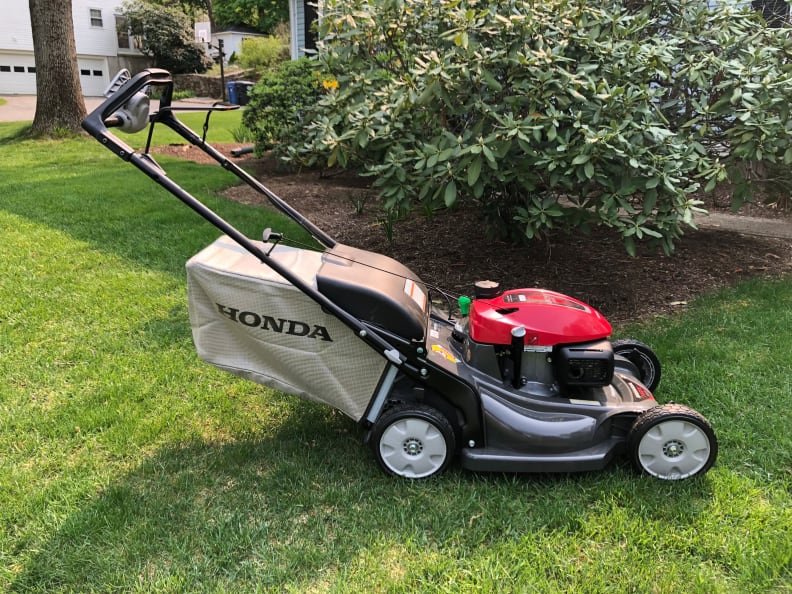
Credit:
Reviewed

The Honda HRX217VKA was a pleasure to use.
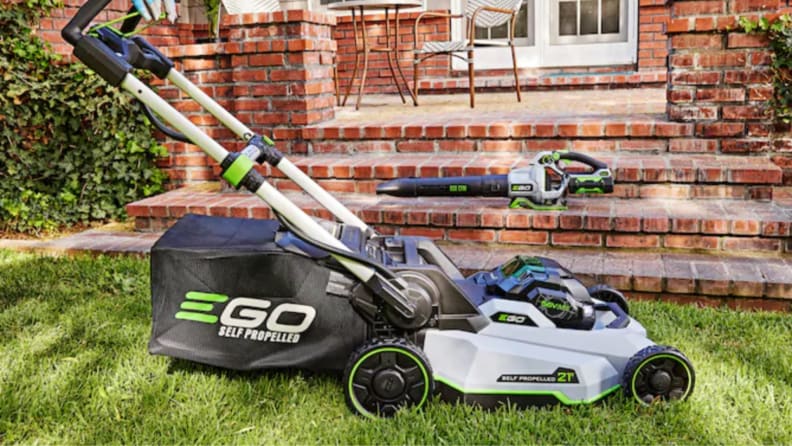
Credit:
Ego Power+

The Ego Power+ LM2135SP is the best electric lawn mower we’ve tested.
Other Lawn Mowers We Tested
How We Tested Lawn Mowers
The Testers
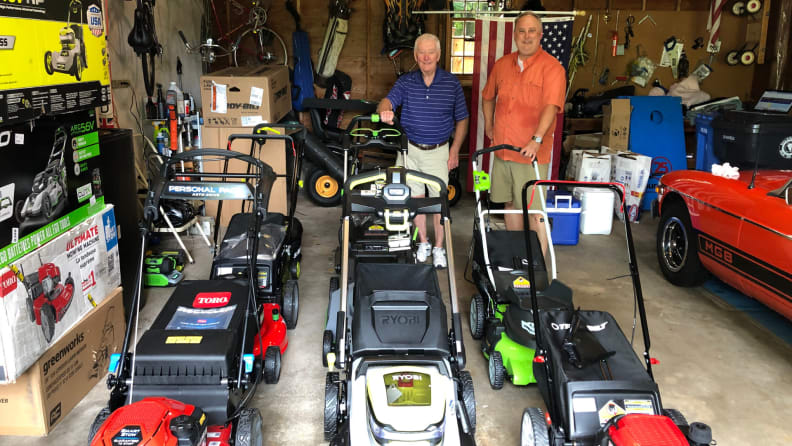
Credit:
Reviewed / Kevin Kavanaugh
We spent the summer mowing a half-acre New England lawn, over and over again.
Kevin Kavanaugh is a retired public school teacher and a product tester for Reviewed. Kevin has been cutting lawns for just about 50 years. He has always been intrigued by all things mechanical, be it watches, power equipment, vintage bicycles, or classic cars.
Ray Lane is a retired supermarket store manager, avid golfer, and product tester for Reviewed. His lawn is the envy of Cumberland, Rhode Island, and he has used several push mowers over the years. At 83 years of age, his input on the mowers was critical, specifically when evaluating ease of starting, maneuverability, and safety.
The Tests
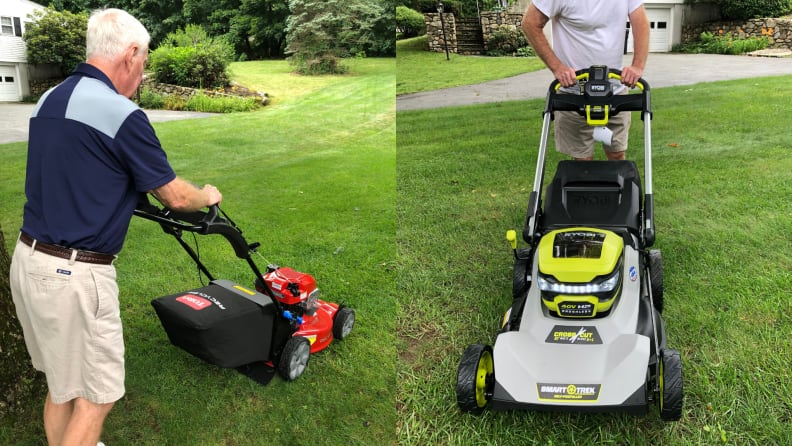
Credit:
Reviewed / Kevin Kavanaugh
We tested lawn mowers on both flat land and hills to test maneuverability and power.
After ordering from retailers like Lowe’s and The Home Depot, we assembled each mower and took note of the ease of the set up and how quickly we could adjust the handle to our preference. We then added gasoline, a battery, or an electrical cord to get the mower ready. We evaluated at the ease of setting the cutting height, first testing a high cutting height and then a lower one.
We took each mower on a few passes of an uncut half-acre lawn, measuring approximately 22,000 square feet, noting how it cut at a high height and a lower height while we monitored both the bagging and mulching features. Then we took each mower up and down a grassy hill to see how they performed. Our final test was testing storage capability.
What You Should Know About Lawn Mowers
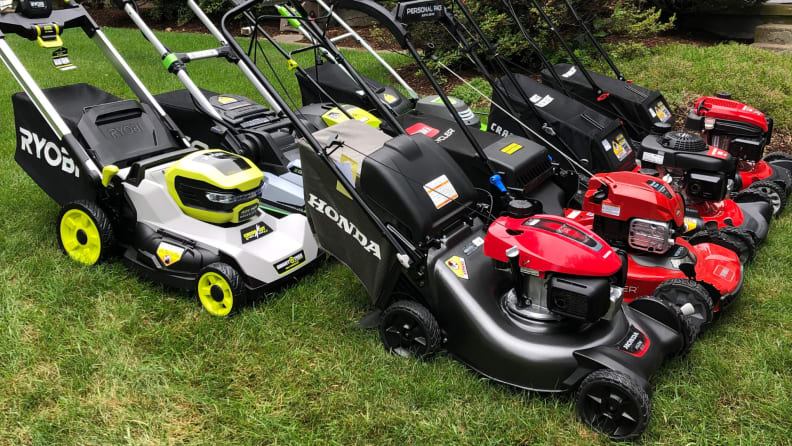
Credit:
Reviewed / Kevin Kavanaugh
Self-propelled lawn mowers can take some of the effort out of walk-behind mowing.
There are two basic types of walk-behind mowers: push and self-propelled.
The push type of mower is usually smaller, lighter, and easier to store. They are used primarily for smaller, level lawns. They are perfect for cleaning up areas that larger riding lawn mowers may miss. They can be run by gasoline, cords, or battery.
Self-propelled lawn mowers usually have a larger cutting diameter and can move on their own through operator controls. These mowers can also be powered by gasoline, cords, or battery. Since they take the brunt of the pushing away, self-propelled mowers are perfect for larger lawns up to a half-acre, and they can easily handle hills and sloped lawns. These self-propelled mowers aren’t fully robotic lawn mowers so you still have to do some work guiding them around your yard.
What Is A Self-propelled Lawn Mower?
The first self-propelled lawn mowers started to appear in the late-1960s. As suburbia grew and lawns got larger, pushing a heavy steel mower around on a summer afternoon wasn’t what most people wanted to be doing.
The first self-propelled mowers had primitive front-wheel drive systems that worked well enough, but the mowers often moved along too slowly. Sure, you weren’t pushing but you were caught in a slow-moving lawn-cutting procession. Early mowers either moved too slowly or too fast to match a natural walking speed.
Today’s mowers offer a much better propulsion system. The Honda NeXite Variable Speed 4-in-1 Gas Walk Behind Self-propelled Mower with Select Drive Control, for example, allows a variety of walking speed settings. Owners can literally dial in their preferred walking speed so that they become one with the mower, not being pulled and not having to push.
The Ego Power+ Select Cut 56-Volt Brushless 21-in Self-propelled Cordless Electric Lawn Mower even allows the operator to drive out to the lawn without the blades turning. That is a great feature.
Today’s self-propelled mowers reduce operator fatigue and make cutting the grass easier than years ago. Self-propelled mowers make cutting on hills safer and more efficient. And with modern speed options they make a summertime chore a little more enjoyable.
Gasoline, Corded Electric, or Battery—Which Lawn Mower is Right for You?
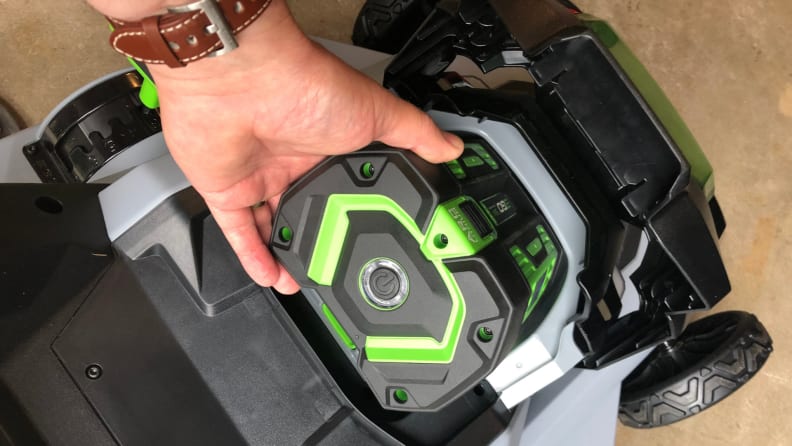
Credit:
Reviewed / Kevin Kavanaugh
Battery-powered lawn mowers can be powerful and efficient.
Gasoline
Gasoline-powered lawnmowers have kept lawns manicured for decades. They are powerful, reliable, and affordable, and come with features such as self-propelled movement, mulching features, and self-cleaning availability. They are powerful enough for large lawn care jobs and can tackle any lawn from a quarter- to half-acre acre. Any lawn bigger than that would necessitate a riding mower.
But gas-powered mowers emit dangerous carbon monoxide and hydrocarbons, require yearly maintenance, and require the storage of gasoline and oil. This may not be suitable for some consumers.
Corded Electric
Corded electric mowers have been around for years and were historically the choice of consumers who had smaller lawns and didn’t need the more powerful gasoline mower. While powerful enough to get most cutting or trimming jobs done, the one obvious drawback to a corded mower is the electrical cord.
For any yard worthy of mowing, a long electrical extension cord is required to power the mower. This can be a minor annoyance, such as having to keep the cord free from getting tangled in trees and bushes, to a major annoyance when you drive over it and cut it into small pieces.
However, corded electric mowers require no gas, oil, or maintenance and, other than a blade sharpening from time to time, can perform reliably for years.
Battery
Battery-powered cars, power equipment, and tools have been around for a long time. The electric motors were strong and reliable enough, but the battery was not. Just a few years ago, an electric car could expect to go only 100 miles on a charge, and power tools and equipment didn’t last long either. In the past few years, battery technology has improved by leaps and bounds.
Electric cars can expect hundreds of miles on a charge and power tools and equipment can last a full day. This lithium battery technology found its way to lawnmowers and it has created a viable option for those consumers who don’t want gas and don’t want a cord. These battery-powered mowers are powerful, efficient, lightweight, and green. Many now use brushless electric motors, which are more efficient, produce more torque, and are longer lasting than the older electric motors with brushes.
How often should I mow my lawn?
Cutting the lawn too often and only cutting it when it gets overgrown are both unhealthy for a lush, beautiful lawn. The rule of thumb in the lawn-care industry is to keep the grass between 3 inches and 3.5 inches in length. This allows the grass to be long enough to thrive in hot, summer weather.
When cutting grass, never take more than a third of the blade at once. In other words, never cut more than an inch or so. Not only does this cause clumping of grass on the lawn or in the mower bag, but it takes too many nutrients and moisture from the grass itself.
After the late winter fertilizer treatments and the often heavy rains, lawns start to come to life. You’ll find that the grass will need cutting every 4 to 5 days in order to remove just enough length. As the summer wanes on and the temperature rises, the grass will grow a bit slower and a once week cutting is adequate.
It is also important to keep the blades of your lawnmower good and sharp. Since the lawnmower blades are often made of steel, they will develop a dull edge after a season of cutting. A dull edge on a blade will tear the grass and not cut it. This may result in browning of the tips of the grass and put more stress on the mower as well.
While you are under the deck checking those blades—and always disconnect the spark plug wire before going under the mower—be sure there is no old clumped up grass clinging to the mower deck.












